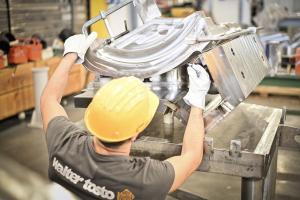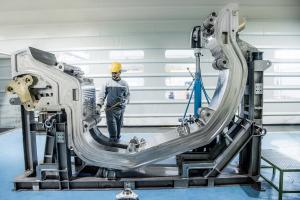Europe awards final contract
Fifty-four divertor cassettes form the backbone of a unique system designed to exhaust waste gas from the ITER machine and minimize impurities in the plasma. In Europe, the final contract for divertor cassette manufacturing has been signed, with delivery expected between 2025 and 2027.
Divertor cassette bodies are uniquely contorted objects that weigh close to 5 tonnes each. Shaped approximately like a "U" with flared edges, each cassette body hosts three targets on its plasma-facing surfaces; on the backside, the cassettes align perfectly with circular rails at the bottom of the vacuum vessel to lock into place.
The cassettes form the backbone of the ITER divertor, designed to withstand heat loads comparable to those that would be encountered at the surface of the Sun and to resist the huge mechanical forces that could be exerted by plasma disruptions. The cassettes provide neutron shielding to the vacuum vessel and a route for divertor water coolant; some also host diagnostics and instrumentation. The shaping and forming of these unique objects in austenitic steel—to extremely demanding specified tolerances—require such a high level of precision machining and proficiency in welding that four years of prototyping and testing were necessary before the manufacturing contracts could be awarded.
The European Domestic Agency Fusion for Energy put European industry to the test through a competitive prototyping phase, during which it worked with different suppliers to help them to develop the necessary know-how and test their skills during production. Beginning in 2013, the Fusion for Energy team supported selected European contractors as they engineered, manufactured and finally tested real-size cassette prototypes. On completion of the prototyping phase in 2018, initial contracts were awarded to the Italian company Walter Tosto (15 cassette bodies) and the Italian-French consortium CNIM-SIMIC (4 cassette bodies) for delivery by 2025.
The remaining cassettes—which presented some added complexity such as the requirement to accommodate specific diagnostics or operational instrumentation—have now been awarded. Walter Tosto will manufacture the remaining 38 units, plus one optional, for delivery by 2027.
See the original article on the Fusion for Energy website.



